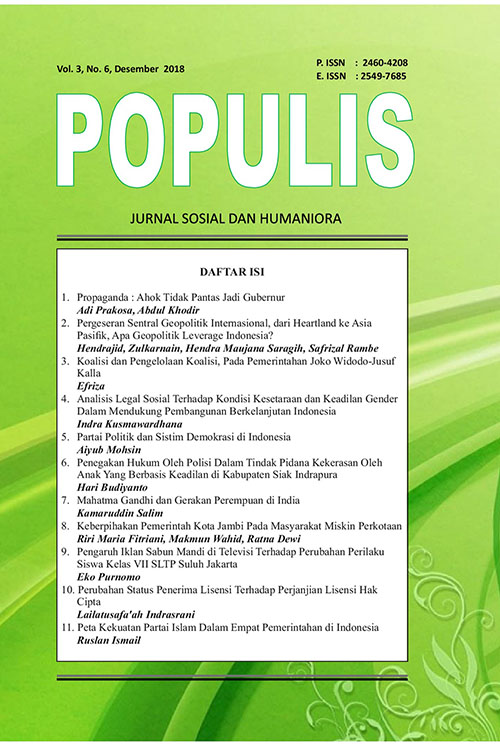KEBERPIHAKAN PEMERINTAH KOTA JAMBI PADA MASYARAKAT MISKIN PERKOTAAN
DOI:
https://doi.org/10.47313/pjsh.v3i2.473Abstract
This study describes and analyzes the alignments of the Jambi City Government to ensuring education and health for the urban poor society at Jambi city. To see whether or not the government has succeeded in carrying out those function, this research will try to reveal it through the implementation of social security in the case of education and health services in Talang Gulo’s Final Waste Disposal Area, Jambi City. This study uses a type of qualitative research with case study approach that is intrinsic case study to find out more about the alignments of the Jambi City government to those who have been far from the reach of government programs. The results of this study are miscoordination between the private sector, and the government in organizing social security. The poor society in Jambi City do not get good social security to live a good life and there is a kind of poverty culture in Talang Gulo which can be seen from some of the poor communities in the region who think their lives are quite like now or in other words structural poverty. The research findings illustrate that the State has failed in organizing social security as a strategy to overcome the welfare problems of the community, especially for those who live below the poverty line.
Keywords: Destitution, Urban, Social Security
References
Andre Bayo Ala, 1981. Kemiskinan dan Strategi Memerangi Kemiskinan, Yogyakarta: Liberty.
Barry J.L., et al. 1997. Digestive and metabolic effects of potato and maize fibres in human subjects. Br. J. Nutr, 77 (1): 33-46.
Barry, C., Morrison, C. M., & Ellis, A. W. (1997). Naming the Snodgrass and Vanderwart pictures: Effects of age of acquisition, frequency, and name agreement. Quarterly Journal of Experimental Psychology A, 50, 560–585.
Barry, C., Morrison, C. M., & Ellis, A. W. (1997). Naming the Snodgrass and Vanderwart pictures: Effects of age of acquisition, frequency, and name agreement. Quarterly Journal of Experimental Psychology A, 50, 560–585.
Creswell, John W, 1998, Qualitative Inquiry and Research Design: Choosing Among Five Tradition, USA: Sage Publication.
, 2009, Research Design:Qualitative, Quantitative and Mixed Methods Approaches, London: Sage Publication.
, 2012, Research Design: Pendekatan Kualitatif, Kuantitatif Dan Mixed, Yogyakarta:Pustaka Pelajar.
Executive Summary dalam Sinopsis Fisipol Research Days 2014.
Hendrik Siregar. 2014. Akhiri Cara Mudah Tambang Habisiss Hutan: Stop Izin Pinjam Pakai Hutan. Jurnal LandReform. Volume 1/Mei 2014.
Holland, J. L., Powell, A., & Fritzsche, B. (1994). SDS professional user’s guide. Odessa, FL: Psychological Assessment Resources, Inc.
Marsh, D dan Stoker, G, 2011, Teori dan Metode Penelitian Ilmu Politik, Bandung: Nusa Media.
Midgley, J. eooo. "The -Definition of soeial policy" dalam J. Midgley, M.B. Tracy dan M.Livermore (ed). The H andbook of social polfcy. sage publication. London, dikutip dari D. Triwibowo. Demokrasi Tanpa Kesejahteraan? Telaah dan Gagasan Bagi Reforma Kebijakan Sosial di Indonesia. Makalah pada Panel Gerakan Buruh di Bawah Tirani Modal dalam Konferensi Warisan otoritarianisme: Demokrasi Indonesia dan Tirani Modal, 5 Agustus 2oo8, Depok.
Sen, A., 1981. Poverty and Famines: An Essay on Entitlement and Deorication, Oxford: Clarendon Press.
Sofia Monsalve Suarez. 2012. The Human Rights Framework in Contemporary Agrarian Struggle. The Journal of Peasant Studies. DOI: 10.1080/03066150.2011.652950.
Word Bank (1999). Coporate Governance: Framework for Implementation, Overview. www.wordbank.org.pp.5
World Bank (2002) Poverty in Pakistan: Vulnerabilities, Social Gaps, and Rural Dynamics. Washington, D.C.: World Bank.
Yogi, S dan Iksan, M, (2006) Standar Pelayanan Publik di Daerah, Penerbit PKKOD-LAN, Jakarta.
Downloads
Published
Issue
Section
License
- Hak publikasi atas semua materi informasi yang tercantum dalam situs jurnal ini dipegang oleh dewan redaksi/editor dengan sepengetahuan penulis. Pengelola Jurnal akan menjunjung tinggi hak moral penulis.
- Aspek legal formal terhadap akses setiap informasi dan artikel yang tercantum dalam situs jurnal ini mengacu pada ketentuan lisensi Creative Commons Atribusi-NonCommercial-No Derivative (CC BY-NC-ND), yang berarti bahwa hanya dengan izin penulis, informasi dan artikel Jurnal BACA dapat didistribusikan ke pihak lain dengan tanpa merubah bentuk aslinya untuk tujuan non-komersial.
- Setiap terbitan Populis Jurnal Sosial dan Humaniora, baik cetak maupun elektronik, bersifat open access untuk tujuan pendidikan, penelitian, dan perpustakaan. Di luar tujuan tersebut, penerbit atau pengelola jurnal tidak bertanggung jawab atas terjadinya pelanggaran hak cipta yang dilakukan oleh pembaca atau pengakses.










